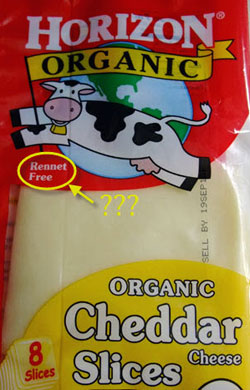Warning: Your Customers May Be Stupider Than You Think!
 I was stymied recently…by cheese.
I was stymied recently…by cheese.
I was at a local high-end grocery store buying meat, produce, and a pile of gluten-free goodies. Richard, who has recently gotten into cooking, decided to make organic hamburgers for dinner. We were out of cheese, so I walked over to the cheese section to pick up some cheddar slices.
I was confronted with a variety of gourmet cheeses. And they were pricey–running about $4.50 for 8 slices!
I picked one at random that said “cheddar” and looked at it. And that’s when I noticed something odd:
Right there, at the top of the package, in the “money spot” — the spot where my eyes went right after reading the brand — it said “Rennet Free.”
What in the world, I wondered, was “rennet”?
My brain immediately came up with this image:

(Oops, that’s a ferret!)
I buy a fair amount of expensive cheese, and I love cheese. As determined by willingness to spend $4.50 on 8 slices of organic cheese instead of going to a mass-market store and buying a block of Velveeta, I’m definitely in this company’s target demographic. But I have no idea what “rennet” is or why it’s important that the cheese be “rennet free.”
As cheesemakers, Horizon is probably well aware of what rennet is. But their customers probably aren’t. In that regard, most of us are “stupider” than Horizon.
I looked up rennet on Wikipedia, and it turns out that rennet is made from calves’ stomachs and is used to turn milk into cheese. Killing baby cows to use their stomach enzymes to make cheese is a bit disturbing. But the Wikipedia article also says that “by 2008, approximately 80-90% of commercially made cheeses in the United States were made utilizing GMO-based (non-cow) rennet.”
Surprisingly, the back of the package doesn’t go into any detail on what rennet is. Horizon missed an opportunity to educate their customers on why it’s important to buy rennet-free cheese.
I bought the cheese, but I didn’t become brand-loyal–I won’t go looking for Horizon again. Horizon missed an opportunity to gain a long-term customer with their label.
Are your labels (or your websites) doing the same thing to potential customers? Let’s take a look at the flip side…
The Flip Side: A Great Label
Here’s an example of a product wrapper that encouraged me to buy a product based on the label alone:

This is Skippy natural peanut butter. This jar is a bit old, but shows exactly why I bought it.
The first thing that motivated me to pick up the jar was the award. It says “2008 Chef’s Best – Best Taste.” This is important to me. I can’t tell you how many brands of peanut butter I’ve tried that don’t taste that great–especially the “natural” variants. The award provides fantastic social proof–other people have liked it, so you will too!
The second thing that got me to put the peanut butter in my cart was the big “No Need to Stir!” headline. Another problem with “natural” peanut butters is that they tend to separate. Skippy has managed to (mostly) fix this. I find myself still needing to stir it sometimes, but it certainly doesn’t separate like a lot of other peanut butters.
Skippy’s label has gotten me to buy at least 10 jars of its peanut butter over the past 2 years. In fact, I now look for their brand first when I buy peanut butter.
Getting Your Customers to Become Brand-Loyal
Skippy really nailed exactly what their customers wanted, whereas Horizon didn’t. Skippy’s jar speaks in easy-to-understand language that even small children would be able to read. Horizon’s package doesn’t.
What would I do if I were Horizon–and what lessons can you take from this?
- I’d survey my customers. In the survey, I would ask what values were most important to them. (Here’s my step-by-step video walkthrough on how to survey your customers for free.)
- I’d redesign my label to get customers to buy. The top value from the survey would get the most prominent placement on my label. I’d remove “rennet free” (or relegate it to the back of the wrapper in the ingredients.) I would make sure even kids understood everything on my label.
- I would consider adding a testimonial from a satisfied customer on the front of the package. Of course, this would need to comply with any legal requirements regarding testimonials. (Consult an attorney in your area to make sure any testimonials you feature are in compliance.)
- As an alternate or addition to #3, I would enter contests to win awards with my product, and then seek permission to display those awards prominently on my packaging.
Even if you aren’t selling a physical product, it’s important to consider what message you are sending to your customers. For instance, is your website reflecting the top values of your customers, or is it all about you and your company?
I went through this exercise a few years ago with my web hosting company and realized I needed to completely redesign our website. I blogged about what I discovered here…it’s worth reading if you’re currently selling products online.
How will you take this lesson to heart and change your website and/or product packaging? Feel free to post in the comments.
Recommended Reading:
- Here’s How to Become Rich: Deliver Value. Change the World. An epic post from 2007 where I apply this concept to my web hosting company’s website. Definitely read this one if you’re doing business online.
- Sharing My Journey To One Million Dollars. Written just after I sold my business, but when I was still in the “embargo period” and couldn’t speak publicly about the sale. I write candidly about the ups and downs of building a $1 million business.
- You Are Worth More Than You Think: Overcoming The Key Reason Entrepreneurs Fail. If you have ever said, “I just don’t have enough time to do [an activity I love]”, this advice is for you…


